
The carousel itself is a museum that needs to be touched and maintained.
Restoration Process
In 1979, the Kit Carson County Carousel was designated a National Historic Site.
John Pogzeba, an art conservator from Denver, was contacted regarding restoration of the 45 oil paintings. In 1977, the oil paintings were restored by Mr. Pogzeba and by Will Morton VIII. Popular cosmopolitan scenes of the Victorian era, the paintings represent European pastoral scenes, world wonders (i. e. pyramids and sphinx), hunting, forest glen, a country cottage and various humorous subjects. Because they are painted on fragile, light cotton muslin, and because so many of them were torn and punctured, they were strengthened by attaching them to new solid panels. The cleaning, which followed, revealed the true brilliance. Most, being in fairly good condition, were simply repainted in a few areas where the painting had been harmed by punctures or minor tears. Others required more extensive restoration because of major tears or water damage.
The carousel was designated a National Historic Landmark in 1987, making it at that time only one of 19 National Landmarks in Colorado and the only one you could ride! That same year Will Morton contracted to restore the original paint to the animals, the four chariots, and the outer rim. This project was completed 18 months later. The carousel building was re-faced with siding and the area around it was landscaped with an eye for Victorian charm.
The jewel that it is, the carousel continues to operate during the warmer seasons, bringing wonder and joy to younger riders and welcome warm memories to the older ones. During the past decade, public enjoyment of the carousel has resulted in a new generation of small gouges, nicks, bruises and cracks, so a "re-restoration" of the animals was undertaken in 1992.
The original valances and cresting on the carousel when it was in Denver probably were destroyed when the carousel was dismantled in 1928 so it could be moved by train to Kit Carson County. In 1997, grants from the State Historic Fund of the Colorado Historical Society and from the Boettcher Foundation financed research, patterns and reconstruction of the valances, restoration of the carousel's original lighting, and additional restoration work on the machinery room, the moldings on the paintings, and the Wurlitzer Monster Military Band Organ
In partnership with the Kit Carson County Carousel Association, National Park Service architect Rick Cronenberger completed a historical structure assessment of the building housing the famous merry-go-round in 1999. This assessment substantiated the need to undertake structural and stabilization work on the carousel building to assure it would stand another seventy-five years.
The completion of the work on the building in 2001 marked the completion of the overall restoration of the carousel which began 25 years earlier.


